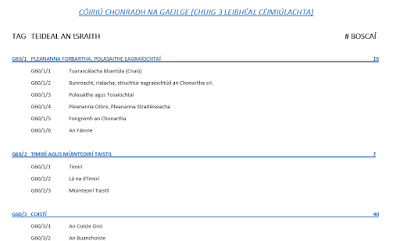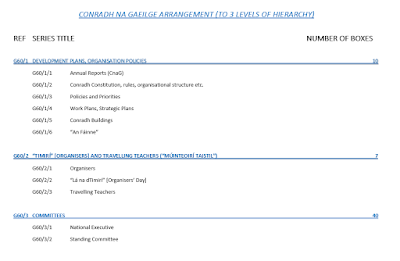Agus an geimhreadh ag teannadh linn, agus
ceann de na himeachtaí is tábhachtaí i saol na Gaeilge, an tOireachtas,
buailte linn, tá sé tráthúil an scéal is déanaí a roinnt libh maidir leis an
obair atá idir lámha ar chartlann Chonradh na Gaeilge. Is é seo an tríú blag i
sraith a bhfuil sé mar aidhm aici spléachadh a thabhairt daoibh ar a mbíonn ar
siúl ag an gcartlannaí - i.e. mé féin! D’inis mé daoibh i gcéad bhlag na
sraithe seo faoi na céimeanna éagsúla atá ríthábhachtach chun bailiúchán a
phróiseáil sular féidir é a chur ar fáil don phobal: bíodh a fhios agat céard
atá agat, déan sábháilte é, déan é a mheas, déan cinneadh faoin leagan amach,
déan é a chatalógú, déan cinneadh faoi cad ba cheart a bheith ar fáil don
phobal agus
ansin cuir ar fáil é. Rinneadh plé níos mionsonraithe sa dara blag ar an
bpróiseas breithiúnais, agus tugadh míniú ar an réasúnaíocht a bhí taobh thiar
den tionscadal ollmhór seo a bhriseadh suas ina thrí chéim: Tús
na hOibre (is é seo an próiseas trína ndéantar ábhar gach bosca a
thógáil amach, a scrúdú, a liostú agus a chur i mboscaí cartlainne speisialta a
stóráiltear ansin i seomraí stórais sábháilte aerchóiriúcháin), Cóiriú agus an
Chéim Dheireanach.
Leanann an blag seo ón gceann deireanach agus
cuireann sé síos ar an obair a bhíonn i gceist nuair atáthar ag teacht ar
chinneadh maidir le cóiriú a chur ar bhailiúchán. Pléitear ansin an chéim dheireanach den saothar
leanúnach seo.
 |
Dhá shampla den eagar a bhfuil trí leibhéal
den ordlathas liostaithe anseo. Beidh
leibhéil eile ordlathais sa bhailiúchán, lena n-áirítear fo-fhoshraith, comhad
agus mír.
|
Cóiriú
Ag deireadh na Chéad Chéime, tá a bhfuil sa bhailiúchán trí chéile cosanta ó riochtaí na haeráide, tá a fhios againn (ag leibhéal bunúsach) céard atá ann, agus tá tuairim againn cén chaoi teacht air.
An chéad chéim eile sa phróiseas cinneadh a dhéanamh maidir le cóiriú. Bíonn smacht intleachtúil againn ar bhailiúchán nuair atá cóiriú curtha air, tugann sé struchtúr dó agus éascaíonn sé an réamhobair atá le déanamh chun go mbeidh na míreanna atá ann inaimsithe ag taighdeoirí sa todhchaí trí ábhar a bhaineann lena chéile a ghrúpáil faoi chatagóirí ar leith i sraitheanna/foshraitheanna/comhaid etc.
Tá dhá fhochéim i gceist leis an gcéim seo:
- Cóiriú intleachtúil
- Cóiriú fisiciúil
Cóiriú Intleachtúil
Bhí orm, ar an gcéad dul síos, teacht ar cóiriú loighciúil chun ciall a bhaint as an mbailiúchán agus gach a raibh ann a dhéanamh a inaimsithe agus ab fhéidir. Is é an nós imeachta a ghlacfaidh an cartlannaí chuige nó chuici féin go hiondúil aon cóiriú reatha a bhí ann a choinneáil. Ar an drochuair, ní raibh sé sin indéanta sa chás seo. Cuimsítear breis agus 125 bliain sa bhailiúchán seo, tréimhse inar bhog ceanncheathrú an Chonartha sé huaire, agus ina raibh 32 uachtarán aige a chuimsigh 35 téarma oifige. Stóráladh ábhar i roinnt suíomhanna, stóráil sheachtrach san áireamh, agus ní raibh aon cóiriú inaitheanta air. Bhí modhanna oibre éagsúla ag rúnaithe éagsúla i gcaitheamh na mblianta, agus ba léir gur bogadh roinnt uaireanta é ón uair a tionscnaíodh é. (Is gnách go dtarlódh a leithéid i gcás eagraíochta chomh mór agus chomh fadsaolach sin!)
Cóiriú Fisiciúil
Tar éis dom an cinneadh a dhéanamh maidir le cóiriú, bhí orm na míreanna a chur le chéile go fisiciúil faoin struchtúr sin. D’fhág sé sin gur thosaigh mé ag céad chatagóir an eagair agus gur bhain mé amach gach ar bhain leis an gcatagóir sin ó gach bosca a raibh a leithéid d’ábhar iontu. Ní beag an líon sin i gcás roinnt de na catagóirí. Mar is féidir libh a shamhlú, bhí go leor ama i gceist leis sin ach ba thábhachtach an obair í. Bhí míreanna a bhain le topaicí sainiúla faoi leith scaipthe fud fad an bhailiúcháin go dtí gur críochnaíodh céim fhisiciúil an chóirithe.
Cad é an Chóiriú?
Tá trí phríomhchuid i gceist leis an cóiriú atá roghnaithe agam, agus cuimsítear leo sin 45 sraith. (Bailiúchán OLLMHÓR atá ann, ar ndóigh!!!)
Cuimsíonn an chéad chuid (sraith 1 – 13) an
eagraíocht féin agus a struchtúr agus san áireamh ann tá tuarascálacha
bliantúla, doiciméid bheartais, comhaid fostaithe, ábhar riaracháin, ábhar
airgeadais, foilseacháin, miontuairiscí na hArd-Fheise, Caidreamh
Poiblí mar aon le hábhar ó chraobhacha agus coistí éagsúla. Baineann an dara
cuid (sraith 14 – 21) leis na hEalaíona agus an Cultúr go ginearálta agus áirítear
leis comórtas bliantúil an Oireachtais, féilte in Éirinn agus
thar lear, ceol, spóirt, drámaíocht agus litríocht. Taighde is mó atá sa chuid
deiridh (sraith 22 – 45), agus san áireamh tá páipéir Dhonncha Uí Shúilleabháin
agus Ghiolla Críost Uí Bhroin mar aon le hábhar a bhaineann le Pádraig Mac
Piarais, Tuaisceart Éireann, an pholaitíocht, ranna Rialtais agus gnólachtaí.
Tá sraith fhairsing ann chomh maith a bhaineann leis na feachtais éagsúla a
reáchtáil an eagraíocht nó a raibh baint aici leo.
 |
Suaitheantais éadaigh an Oireachtais ó na
1940í nó na 1950í agus biachlár ó 1979
|
Tá struchtúr anois agam faoin cóiriú seo chun uimhreacha tagartha a eisiúint do gach sraith, foshraith, comhad agus mír. Tugadh an cód G60 ar bhailiúchán Chonradh na Gaeilge, mar shampla. Tá a fhios agam anois, i bhfianaise 45 sraith a bheith ann san iomlán, go dtósóidh na cóid sraithe ag G60/1 agus go gcríochnóidh siad ag G60/45, agus go leanfar leis an uimhriú de réir ordlathas an chóirithe e.g. tabharfar an cód G60/19/2/3 ar an tríú comhad sa 2ú foshraith den 19ú sraith!
Catalógú
Agus an dara céim curtha i gcrích, tá sé in am an bailiúchán a chatalógú. Ní bheidh sé indéanta don taighdeoir uirlis chuardaigh a úsáid chun fáil amach céard atá sa bhailiúchán ar féidir féachaint air go dtí go mbeidh an catalógú curtha i gcrích. Is é atá i gceist le catalógú cur síos a dhéanamh ar bhailiúchán, sraith, foshraith, comhad nó mír, ar cur síos é sin a insíonn don taighdeoir ní hamháin a bhfuil i gceist leis ach an comhthéacs chomh maith. Tá gnáthréimsí sonraí le comhlánú ag an gcartlannaí gairmiúil ag an staid seo agus ní mór dó nó di treoirlínte diana tuairisciúla a leanúint chun cloí le dea-chleachtas. Cuirtear an t-eolas sin ansin isteach i mbunachar sonraí (cartlainne) CALM.
 |
Gabháil scáileáin den chrann taifead in CALM
(bunachar sonraí cartlainne) ina bhfuil gach ceann den 45 sraith ar
taispeáint.
|
I gcás bailiúcháin chomh mór leis an gceann seo, is é an bealach is sábháilte chun a chinntiú go gcloífear leis na cleachtais is fearr ná cur síos a dhéanamh ar an mbailiúchán go céimneach ón leibhéal bailiúcháin síos go dtí an leibhéal comhaid nó fiú an leibhéal míre, agus cinntiú go bhfuil gach céim críochnaithe sula mbogfar ar aghaidh chuig an gcéad chéim eile. Tá áthas orm a bheith in ann a thuairisciú go bhfuil an cur síos ag an Leibhéal Bailiúcháin agus ag an Leibhéal Sraithe críochnaithe anois. Tá mé ag obair anois ar liostú ag leibhéal níos ísle den ordlathas (e.g. fo-fhoshraith / comhad) agus tá mé an-sásta a bheith in ann a rá go scaoilfimid le codanna den bhailiúchán i gcodanna de réir mar a chríochnaítear iad. Déanfaimid amhlaidh mar gheall ar an méid spéise atá á chur sa bhailiúchán agus mar go bhfuil sé chomh mór sin, agus ionas nach mbeidh ar thaighdeoirí fanacht go dtí go mbeidh cur síos déanta ar an mbailiúchán ina iomláine. Déanfaidh mé sin chomh tapaidh is atá mé in ann, ach ní mór foighne a bheith agaibh! Díreach mar go gcuirtear cuid amháin ar fáil, ná glac leis go mbeidh an chéad cheann eile sna sála air!
Gnéithe eile le cur san áireamh
Tá dhá shaincheist eile atá luaite agam cheana féin a bhfuil aghaidh le tabhairt orthu ag an gcéim seo, is iad sin cinntí a dhéanamh maidir le hinrochtaineacht i gcomhthéacs GDPR agus breithnithe eile chun go mbeifí comhlíontach leis an reachtaíocht agus, ar an dara dul síos, míreanna a roghnú le haghaidh a ndigitithe. Sa chás gur bailiúchán beag atá i gceist (roinnt boscaí cartlanna, mar shampla), tá sé in ann a bheith éasca teacht ar na hacmhainní chun é a dhigitiú ina iomláine, agus an bailiúchán ar fad a chur ar fáil ar an gcaoi sin (seachas na taifid sin nach mór iad a bheith dúnta ar aon chuma chun bheith comhlíontach le GDPR etc.). I gcás bailiúchán ollmhór cosúil leis an gceann seo, ní raibh sé indéanta i dtéarmaí praiticiúla gach uile rud a dhigitiú. Tagann saincheisteanna cosúil le ham, costas agus stóráil chun cinn, faraor. Tá deacracht ann chomh maith ó thaobh an comhthéacs a bhaineann le gach íomhá a choinneáil, go háirithe mura bhfuil sí liostaithe ag leibhéal míre. Ní mór, mar sin, roghnú cúramach agus pragmatach a dhéanamh. De réir mar a leanaim le próiseáil agus le liostáil an bhailiúcháin, tarraingím aird ar na míreanna a bhféadfaí iad a dhigitiú amach anseo.
Cur ar fáil
Ar aghaidh linn chuig an dea-scéal mar sin! Mar a luadh cheana, beidh sraitheanna á gcur ar fáil againn don phobal i gcodanna chun ligean do thaighdeoirí rochtain a fháil ar na codanna sin den bhailiúchán atá críochnaithe sula gcríochnófar an liostáil go hiomlán. Cuirfear na codanna sin ar fáil ar bhonn eatramhach i rith na bliana seo chugainn de réir mar a chríochnaítear iad. Tá tús áite á thabhairt do shraitheanna bunaithe ar líon fachtóirí, lena n-áirítear méid, spéis don taighdeoir, moltaí ón ngrúpa sainspéise, a éasca a bheidh sé iad a chur ar fáil agus ábhair imní maidir le GDPR.
Céard atá á chur ar fáil?
Sé shraith atá i gceist leis an gcéad chuid roimh Oireachtas na bliana seo: “Craobhacha, Coistí Ceantair agus Dála Cúige”, “Comhaltas Uladh”, “Drámaíocht, Amharclannaíocht agus Scannánaíocht”, “Spóirt”, “Pádraig Mac Piarais” agus, ar ndóigh “An tOireachtas”. I measc an ábhair a mbaineann spéis faoi leith leis áirítear craobh Londan agus Ard-Chraobh CnaG, litreacha ó Bhreandán Ó Beacháin agus Seán O’Casey faoi dhrámaí i nGaeilge, ábhar a bhaineann le Scoil Éanna, cláir, cuirí agus boinn comórtais. Cuimseofar tréimhse ama ó na 1890í go dtí an lá atá inniu ann sa 72 bosca ábhair a osclófar. Chun tuiscint cheart a fháil, áfach, ar shaibhreas an ábhair in aon cheann de na sraitheanna seo, moltar duit lá a chur i leataobh chun cuairt a thabhairt orainn anseo in OÉ Gaillimh, agus a bheith ag treabhadh leat trí na boscaí tú féin!
 |
Dhá ghrianghraf ó leabhar cuntas craoibhe i
Londain a n-áirítear leis scoil in Highgate a raibh ranganna Gaeilge ar siúl
inti.
|
An chéad chéim eile
Cuirfear an chéad chuid eile ar fáil (má spáráiltear muid!) go gairid roimh an Nollaig, agus eiseofar tuilleadh in 2020. Chun súil a choinneáil orthu, bí ag faire amach d’fhógraí eile amach anseo ar an mblag seo nó ar twitter (@nuigarchives).
Go dtí sin, bainigí taitneamh as na híomhánna seo a thugann blaiseadh beag dá bhfuil ann!
 |
An clár do “An Comhar” (aisteoirí Bhaile Átha
Cliath) in Amharclann na Cathrach in 1925
|
 |
Seic a scríobhadh do Phádraig Mac Piarais do
agus thar ceann Scoil Éanna in 1912. Tá síniú an Phiarsaigh ar chúl.
|
 |
Póstaeir
Chumann Lúthchleas Gael do Chraobhchomórtas Iománaíochta Sóisearach, gan dáta
ach deireadh na 1950í is dócha
|
Go dtí an chéad uair eile,
Beirigí bua,
Niamh

















